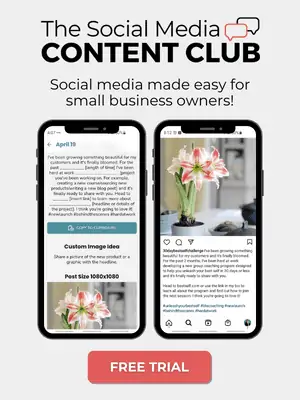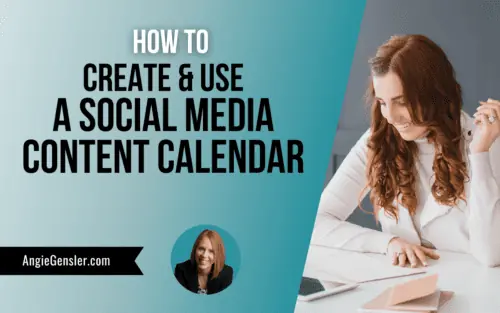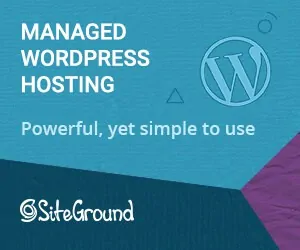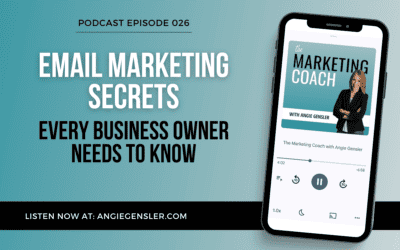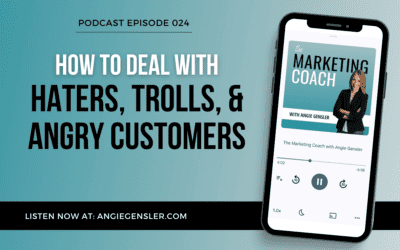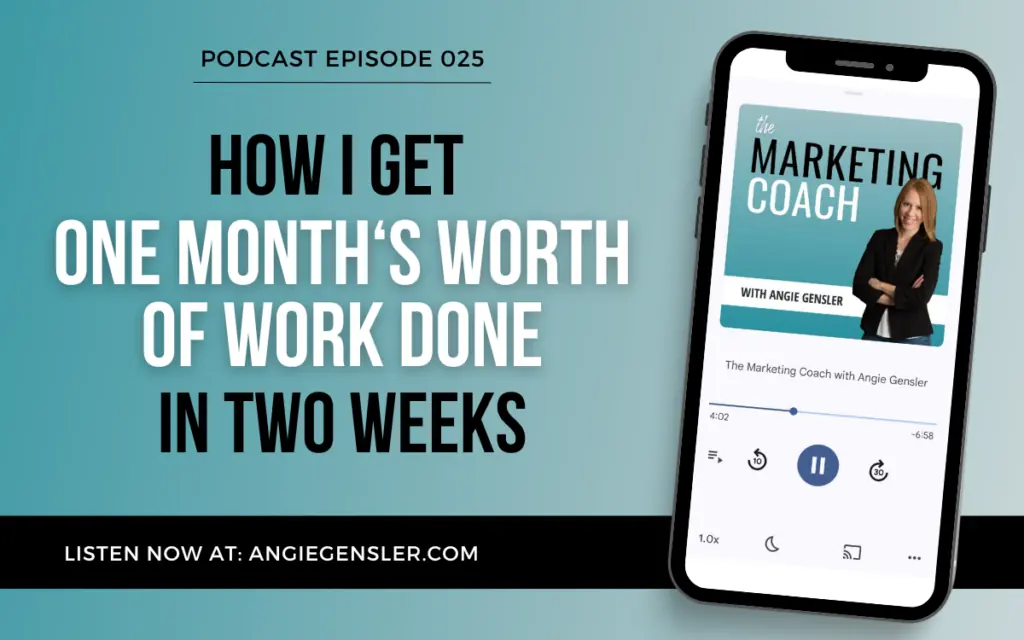
Welcome to The Marketing Coach podcast, the go-to destination for savvy small business owners seeking to boost their traffic, leads, and sales without the hassle and headaches.
Ever felt bogged down by endless to-dos?
Tune in as I reveal my method that skyrocketed my productivity—finishing a month’s work in two weeks! It’s a game-changer for entrepreneurs craving big results minus the burnout.
Inside this episode, you’ll learn about:
- My secret method for accomplishing a massive amount of work in just two weeks
- How to implement this method in your own business and unleash your productivity potential
- The sticky note strategy to transform your workload
- How to break down tasks into manageable chunks and organize them effectively
- The psychological benefits of achieving small victories
- The importance of daily check-ins and how it keeps you focused and motivated
Links Mentioned in the Episode:
- Book – Scrum: The Art of Getting Double the Work Done in Half the Time
- Photo of my scrum board shown below
- Social Media Content Club – Start Your Free 7-Day Trial.
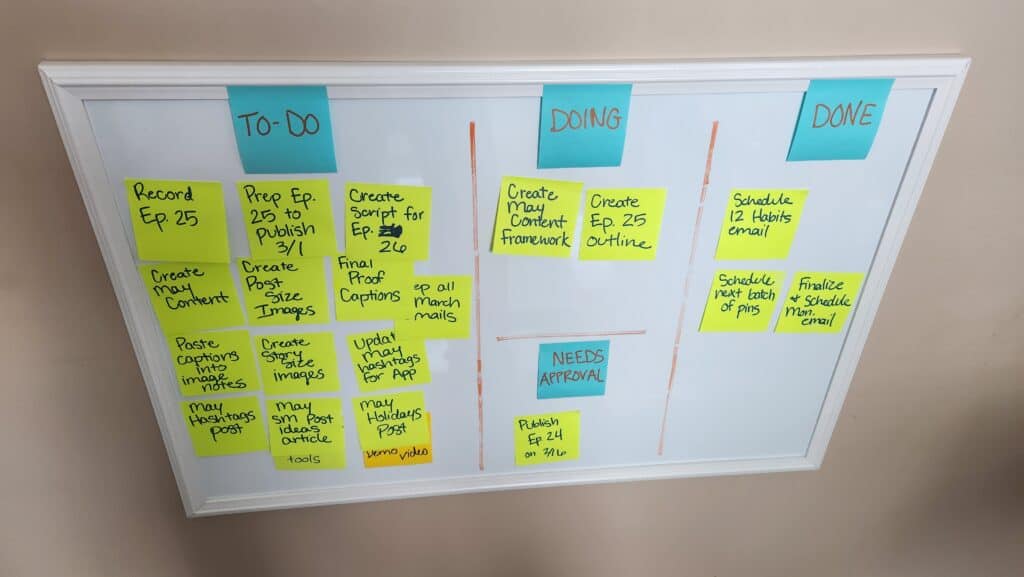
*Disclosure: This post contains affiliate links. If you make a purchase using one of these links, I may receive a small commission. Please know that I only recommend products I have used and that I sincerely think will help your business.
Please Leave a Review
If you liked this episode, please support the show and leave an honest rating or review on Apple Podcasts or your favorite podcast app.
Keep Listening
- Episode 24: How to Deal with Haters, Trolls, and Angry Customers
- Episode 23: Marketing Strategies Every Business Needs in 2024
- Episode 22: Are Reels Worth Your Time on Social Media?
Transcript with Timestamps
This transcript was generated with AI assistance and may include minor spelling and grammatical errors. For the best experience, we recommend listening to the audio version of the podcast.
00:05
Welcome to the Marketing Coach podcast. I’m your host, Angie Gensler, and I teach you how to get more traffic, leads, and sales without the hustle or headache. Let’s get started.
00:17
Hey guys, today I wanna share with you my secret to getting a shit ton of work done in just two weeks. Now, this is a strategy that I developed based on a productivity method called Scrum, and Scrum was originally developed for software development teams, but I’ve adapted their process in order to work for myself and my own small business. Now, if you want to learn about the original process of Scrum, you can grab the book titled Scrum The Art of Doing Twice the Work and half the Time, it is a really great book and I will link to it in the show notes, but you don’t have to read that book to gain the benefits because in this episode I’m going to walk you through the process that I developed and adapted from Scrum to apply to a team of one or a small business.
01:04
This podcast episode came about after I was complaining to Trevor that I didn’t have time to develop some new products that I was really excited about. I had some great ideas and I really wanted to dive into them, but I just did not have time. And he actually challenged me to see if I could get everything done for my business that I needed to get done in an entire month if I could do it all in two weeks. Now, the reason he suggested this is because in the past when we’ve done really huge projects like a new website design or maybe we were transitioning to a whole new payment processor, these massive projects, we would run two week sprints using this scrum method that I’m about to talk to you about. So Trevor knew that I was capable of doing an insane amount of work in a two week sprint.
01:52
So when he challenged me, I stepped up and I rose to that challenge and I blocked off two weeks on my calendar. And what happened was nothing short of amazing, the outcome completely blew my mind. But I will tell you, during that first week, I had my doubts. The kids were home from school for two different days during that week for different weather reasons. And I really thought, okay, there is no way I’m gonna be able to get everything done when two days of my first week have already been blown up. But I kept at it, I didn’t give up and I kept at it. And by Wednesday of that second week, I had completed everything on my list and then I had to start adding more things to keep me busy on Thursday and Friday. It was really insane. And then those next two weeks, because I did all of the work for the next month in two weeks, then I had two weeks completely open and free where I was able to pursue that passion project and work on those other products that I was really excited about.
02:55
You know, I was so jazzed about it. I was telling my sister and some friends of mine, and based on the reactions, I realized, oh, this is really incredible. I need to share this with my podcast listeners. They could really benefit from this. So let me walk you through how the process works so that you can implement it in your own business. So the first thing you want to do is block off a two week time period that you’re going to be hyper-focused and go all in on a huge pile of work. So open up your calendar and find two weeks that seem fairly free, and I’m meaning you, you’re not going on vacation. You don’t have kids off for like multiple days at a time that you know of. You know, you don’t have days and days of meetings or a conference going on.
03:40
You have a fairly open two week time period. So block that off on your calendar. And then I want you to acquire either a whiteboard, a corkboard, or empty space on a wall. This is going to be some surface that you can use that you can put sticky notes on and move them around. And the surface is called your scrum board. Now, you could do it digitally with a tool like Asana or Trello, but I do not recommend doing this digitally. You really want something physical and tangible that you can touch. And I say this as someone who loves Asana. I use that to help me manage all of my tasks digitally. But when it comes to running a two week sprint with this method that I’m gonna share with you, you really need something tangible that you can see, you can touch and you can manipulate because for whatever reason, it’s going to help you move so much faster through your sprint to have something tangible that you can touch.
04:39
Okay? So once you have your surface that you’re going to use as your scrum board, I want you to divide the board into four different sections. The first section is going to be labeled to do. Your second section is labeled doing. The third is labeled needs approval. And the fourth section is labeled done. And you’re going to be placing sticky notes in each of these sections. So your to do section should be the largest because that’s going to hold all of your sticky notes. And then your done will be the next largest. And I say it’s the next largest because you can stack ’em on top of each other. You don’t need to be able to see them all. So it your done section doesn’t have to be as big as the to-Do section. And then your doing section needs to be able to hold about four sticky notes at a time more if you are running a larger team.
05:31
And then your needs approval section can be really small and really only needs to hold about two sticky notes at a time, again, possibly more. If you have a larger team. As I explain more of this, you’ll understand why and, and you’ll get a better feel for how you should lay out your board. I’ll also share a photo of my own scrum board in the show notes so that you can see how I’ve sectioned out my board and you can see exactly how these sections work and how the sticky notes fall within them and how I’ve kind of broken them out. Now, before I move on to the next step, I do have a quick favor to ask of you. If you have been enjoying this podcast, I would be so grateful if you would just take a moment and leave a quick review on iTunes.
06:14
Reviews are so important in helping this podcast reach a bigger audience and help more people. So if you’ve found the episodes helpful, please take a moment and share your thoughts on iTunes. It would mean the world to me and I would be so grateful. Okay, let’s move on to the next step. So once your scrum board is ready, you’ve got your surface, you’ve broken it out into those four different sections, then you wanna get a big stack of sticky notes. Now, if it is just you in your business or just you running this sprint, any color of sticky note is fine, but I do recommend you stick to one color. If you have multiple colors, your board is going to feel very chaotic and overwhelming. So try to stick to one color if you can. If you work with multiple people, if you have a team of employees working on all the tasks for the month, then try to assign a certain color sticky note to each person that makes it visually easy to see who’s working on what you can kind of see the load of work that certain people have going on.
07:15
It makes it a lot visually easier to run through this process quickly. So once you have your sticky notes, I want you to do a huge brainstorming session of everything that you need to accomplish in a month in order to run your business. So for me, I’ll give you an example of what this could look like for me. This included things like writing all four weekly emails that I plan to send in the next month, writing all the captions and designing all the images for the next month of the content club. Updating my monthly blog posts about the hashtags, holidays, and content ideas for the month, creating the outlines for my podcasts and recording them and getting them scheduled to publish writing blog posts and scheduling them to be published and creating all the social media content for the month and scheduling it out.
08:05
So those were just some of the things that were included within my two week sprint. So notice that I didn’t include some of those day-to-day tasks that have to be done no matter what. So things like customer service, jumping in social media and responding to comments, replying to emails, those types of day-to-Day routine functions, routine tasks do not need to go within your two week sprint, but just keep in mind you still have to do those tasks. So there will still be some time of each of your days within this two week sprint and possibly even with the two weeks that you take off that you still have to complete these routine day-to-day tasks that you have to do just to keep your business operating. Now, when you’re doing your big brainstorming session of all the tasks that you have to complete, I recommend doing this on your computer on a Word document that makes it a lot easier to just type them out very quickly and just document absolutely everything that you can think of that needs to be done.
09:02
And once you’ve got that list complete, you’re gonna whip out your sticky notes and a sharpie and you’re gonna start writing each task on a sticky note and then adding it to the to-do section of your board. Now keep in mind that these tasks, they need to be like individual one at a time, smaller type tasks that you can check off. So for example, I have a podcast I wouldn’t write create three podcast episodes for March on a sticky note that might have been written on my Word document in my brainstorming. But then you need to break those bigger items down into these smaller tasks. So for that example of record three podcast episodes for March. Instead on one sticky note, I would write create outline for podcast episode 26. On the next sticky note, I would write record podcast episode 26. On another, it might say Edit podcast episode 26.
10:04
And then on the last one it might say Load and Schedule podcast episode 26. So that was four sticky notes just for one podcast. So I would need to do that for all three. So that one item in my Word document brainstorm that says Record three podcast episodes for March. I might have 12 different sticky notes just to be able to complete that one kind of overarching task. So hopefully that gives you an idea of how you really wanna break these down into little bite-sized pieces that you can check off. And there’s a reason for this, we’ll get into it just a little bit later. There’s a couple different reasons for doing this. Okay? Now, when you’re writing these sticky notes, if it’s just you, and in my case, all of those tasks are done by me. So you would use all the same color for your sticky notes.
10:52
But if you have a team, maybe you write the outline and you record your podcast, but then someone else edits it and a totally different person then loads it and schedules it, then you would need to write those tasks on different colored sticky notes to coordinate with the person that needs to complete them. So once you are done moving all those ideas that you brainstormed onto sticky notes, you should have a ridiculous amount of sticky notes in your to do section and you can just leave them there, kind of just all thrown in that to-do section. That doesn’t matter. But for me, I like to make sense of all the sticky notes. I am hyper organized, so I like to take a little time and I organize them on my board in the order that I plan to complete them. And I also, I use a pretty small board, so some of them have to hide behind other ones.
11:41
So that’s why I like to get them all organized and I can do them in order, which for me, that means all the sticky notes related to creating content for the social media content club. Those are all at the top of my board because that is my number one priority because I wanna take the best care of my pain members, which if you’re not a member of the social media content club and you wanna give it a try, you can head over to angie ginsler.com/content club and you can go ahead and start a free seven day trial over there. Okay, let’s get back to your scrum board. So you’ve got all those sticky notes in your to-Do box, possibly organized in order, but it’s not necessary. Now what the heck do you do? It’s all there. It probably seems overwhelming to see all these items you have to get done in two weeks.
12:27
So what do you do next? So this scrum board is really going to be your guide. It’s gonna be your home base for your two week sprint. So each morning, before you start your work, I want you to stand in front of your scrum board, take a look at it and decide what you’re going to move into the doing section. So if it’s just you and your business or just you running this two week sprint, you may only move one or two sticky notes over into that doing section. If you have a whole team, you might be moving 10 or more over into the doing section, and then you are going to power through whatever that task is that you put in your doing section. You’re gonna power through it until you can move it to either the needs approval or the done section. And let me tell you, the satisfaction that you will feel from moving that sticky note into the done section is so intense that you will be hooked.
13:21
You’re gonna wanna just move right to the next item so that you can move another sticky note into your done section. I’m not kidding. The satisfaction of that is so sweet that oftentimes I will end up doing something that didn’t have a note, and I’m a little embarrassed to say this, but then I will write a sticky note and I will put it on my board just so I can move it across the board to the done section, because the satisfaction that you get from doing that is so sweet, and that’s part of what makes this process work so well. And that’s also why you wanna break these tasks into the smaller chunks and smaller items that you can check off because that satisfaction of moving that sticky note is so great that will energize you and power you to keep going. So if you write record a podcast episode, well one that doesn’t fully encompass everything that needs to happen, but if in your mind you think that that means record it and edit it and schedule it and post it, it’s going to take you a lot longer to complete that task When you break that down into four different chunks, now you can move those sticky notes across the board.
14:35
It gives you some satisfaction, it energizes you, and it powers you to keep working. So your ability to write the outline, record the episode, edit the episode, and load it and get it scheduled to publish the ability to complete those items, you can actually do them so much faster when you have them chunked into those little bite-sized pieces. So that’s why we break it down into these smaller pieces. It’s really, you’re kind of playing this psychological game with yourself and really knowing how the human brain works and how we feel rewarded and satisfied and fulfilled with our work. This Scrum board process all plays into that to help keep you focused, keep you motivated, to keep you energized and excited about the work that you’re doing. Now, in order to make this whole process work and to successfully complete your two week sprint, you really have to stay dedicated to moving those sticky notes across the board over the next two weeks.
15:31
So if you have a team, make sure that you meet at the board every single morning and possibly again in the afternoon to discuss what everyone is working on, what needs approval, and what needs to happen next. Now, if your team is remote, you can still do this. You don’t all have to physically be at the board. Just make sure that there is one person who is owner of the board and they are sharing it in a video chat. And so everyone can see the board when you have these morning meetings. And if you don’t have a team, if it’s just you, same thing. You want to make it a priority to head to that board every single morning before you start your work. Take a look at it, look at what needs to still be done, what are you working on that was left over from yesterday that you could complete?
16:16
Is there anything that needs approval? And who needs to approve it? Whether it’s you or someone else outside of your company, maybe it’s your accountant or some sort of contractor that you’ve hired to help you. And then take a look at the to-do items and what you think you could realistically get done for the day and just work through that board. Now, even though the satisfaction of getting a shit ton of work done in two weeks is extremely fulfilling and very rewarding, you still want to make sure that there is going to be some sort of reward at the end that you or your team can look forward to. So if it’s just you and your business, maybe your reward is to take the following week or even the next two weeks off of work. Give yourself a break. Maybe you go on vacation or maybe you just lay around your house and read a book and take baths all day.
17:02
You know, whatever it is that you could possibly dream of, give yourself some time off. Maybe you book yourself a massage or you go rent a boat on your local lake and have a lake day. Whatever it is, find some sort of reward that you can look forward to that keeps pushing you to moving those sticky notes across your board. And if you have a team, think about giving your team some sort of financial bonus if they complete everything that needs to be done in that sprint in those two weeks. Or maybe you could give everyone on the team an extra day off, or you could even throw them some sort of team party. Find some way to reward and incentivize your team to, you know, push, keep pushing through that sprint to get everything done and then reward them once they have completed it.
17:47
So that is how my process to getting a ton of work done in two weeks works. I hope you guys found this helpful and I really hope you give it a try. If you do end up trying this out, please let me know how it goes. I would love to hear your results and and what you thought of the process. It would really make my day to know that this episode helped someone else out. And before we part ways. Remember that perseverance, not perfection, is the key to success. If you keep taking action, your success is inevitable. I’m cheering you on. If you liked this episode and learned something new. Make sure you rate review and subscribe to the podcast. And if you haven’t given the Social Media Content Club a try yet, head over to Angiegensler.com/content club to start your seven day trial of done for you, copy and paste content directly from your phone. You’re going to love it. Well, that’s it for today. Have a great day, and I will see you in the next episode.




